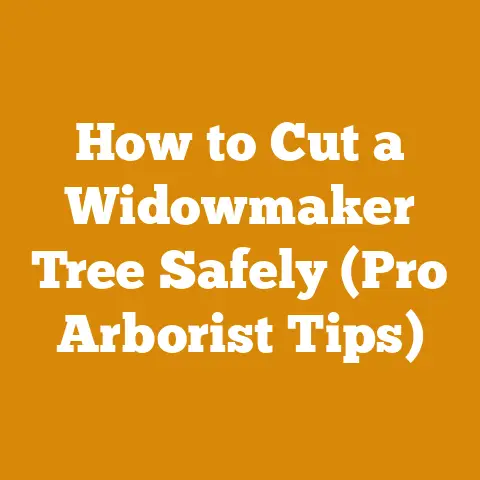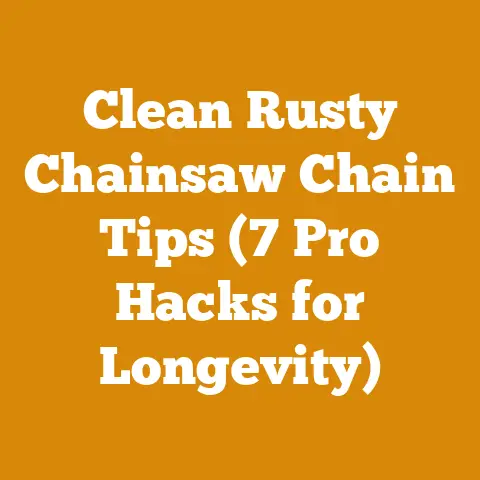Affordable Stump Grinder Tips (5 Pro Hacks for Clean Cuts)
Would you rather spend a fortune on professional stump grinding services every time you have an unsightly stump in your yard, or would you prefer to tackle the job yourself and save a significant amount of money? If you’re leaning towards the latter, then you’re in the right place. I’ve spent years wrestling with stubborn stumps, from small backyard remnants to behemoths left behind after storm damage. Through trial and error, and a healthy dose of research, I’ve developed a few go-to techniques that make stump grinding not only affordable but surprisingly efficient.
This guide isn’t just about removing stumps; it’s about reclaiming your land, saving money, and gaining a rewarding sense of accomplishment. I’ll share five pro hacks that have consistently delivered clean cuts and transformed my approach to stump grinding. Whether you’re a seasoned DIYer or a complete novice, these tips will equip you with the knowledge and confidence to tackle your next stump grinding project like a pro.
Affordable Stump Grinder Tips: 5 Pro Hacks for Clean Cuts
Stump grinding might seem daunting, but with the right approach, it can be a manageable and cost-effective task. These hacks are designed to maximize your efficiency, minimize wear and tear on your equipment, and, most importantly, ensure a safe and clean job.
1. The Right Tool for the Right Job: Understanding Stump Grinder Options
Before you even think about firing up a stump grinder, you need to choose the right one. Renting or buying the wrong type can lead to frustration, wasted time, and potentially dangerous situations.
Types of Stump Grinders:
- Walk-Behind Stump Grinders: These are the most common type and are generally the most affordable for rental. They’re best suited for smaller to medium-sized stumps (up to around 12-18 inches in diameter).
- Tow-Behind Stump Grinders: These are more powerful than walk-behind models and are designed to be towed behind a truck or SUV. They’re suitable for larger stumps and more challenging terrain.
- Self-Propelled Stump Grinders: Similar to walk-behind models, but with the added convenience of self-propulsion, making them easier to maneuver, especially on uneven ground.
- Hydraulic Stump Grinders: These are the heavy hitters of the stump grinding world. They offer the most power and are capable of tackling even the largest stumps. They are typically mounted on a skid steer or excavator.
Choosing the Right Size:
The size of the stump grinder you need depends on the diameter and type of wood of the stump. A general guideline is:
- Small Stumps (less than 6 inches in diameter): A small walk-behind or even a specialized axe designed for stump removal (like a Pulaski axe) might suffice.
- Medium Stumps (6-18 inches in diameter): A walk-behind stump grinder is usually adequate.
- Large Stumps (18-36 inches in diameter): A tow-behind or a more powerful walk-behind model is recommended.
- Extra-Large Stumps (over 36 inches in diameter): A hydraulic stump grinder is the best option.
Rental vs. Purchase:
For most homeowners, renting a stump grinder is the more economical option. The cost of purchasing a stump grinder can range from a few thousand dollars for a small walk-behind model to tens of thousands for a hydraulic unit. Rental costs typically range from $100 to $400 per day, depending on the size and type of grinder.
My Experience:
I once rented a walk-behind stump grinder to tackle a series of small to medium-sized pine stumps in my backyard. The stumps were left behind after I had to remove several trees due to storm damage. While the walk-behind grinder was sufficient for the smaller stumps, it struggled with the larger ones. The teeth dulled quickly, and the process was slow and tiring. I learned the hard way that choosing the right tool for the job is crucial. For my next stump grinding project, I rented a tow-behind model, and the difference was night and day. The more powerful engine and sharper teeth made the job much faster and easier.
Data and Insights:
According to a study by the Arbor Day Foundation, the average cost of professional stump grinding is around $2 to $3 per diameter inch. This means that a 24-inch stump could cost anywhere from $48 to $72 to have professionally removed. Renting a stump grinder and doing the job yourself can save you a significant amount of money, especially if you have multiple stumps to remove.
Key Takeaway:
Carefully assess the size and type of stumps you need to grind before renting or purchasing a stump grinder. Choose a machine that is powerful enough to handle the job efficiently and effectively. Don’t be afraid to ask the rental company for advice on which model is best suited for your needs.
2. Sharpen Your Teeth: Maintaining Cutting Efficiency
The sharpness of the stump grinder’s teeth is paramount to its performance. Dull teeth will not only slow down the grinding process but also put unnecessary strain on the machine’s engine and potentially damage the teeth themselves.
Identifying Dull Teeth:
- Slow Grinding: If the grinder is taking longer than usual to cut through the stump, the teeth are likely dull.
- Excessive Vibration: Dull teeth can cause the grinder to vibrate excessively, making it difficult to control.
- Burning Smell: A burning smell can indicate that the teeth are rubbing against the wood instead of cutting it cleanly.
- Visual Inspection: Examine the teeth for signs of wear, such as rounded edges or chips.
Sharpening Techniques:
- Angle Grinder: An angle grinder with a grinding wheel is the most common tool for sharpening stump grinder teeth. Use a light touch and maintain the original angle of the cutting edge.
- Diamond Grinding Wheel: A diamond grinding wheel is more durable than a standard grinding wheel and can provide a sharper edge.
- File: A hand file can be used for touch-up sharpening between more thorough grinding sessions.
Frequency of Sharpening:
The frequency of sharpening depends on the type of wood you’re grinding and the condition of the teeth. As a general rule, you should sharpen the teeth after every 4-8 hours of use. However, if you notice any of the signs of dull teeth mentioned above, sharpen them immediately.
My Experience:
I once made the mistake of trying to grind a large oak stump with dull teeth. The grinder struggled to make any progress, and the teeth quickly became even duller. I ended up spending hours on a job that should have taken only a couple of hours. After that experience, I made it a point to always sharpen the teeth before starting any stump grinding project. I also learned to carry a sharpening tool with me so that I could touch up the teeth as needed during the job.
Data and Insights:
According to a study by a leading manufacturer of stump grinder teeth, sharp teeth can increase grinding efficiency by up to 50%. This means that you can complete the job in half the time and use significantly less fuel. Sharp teeth also reduce the risk of damaging the stump grinder and extend the life of the teeth.
Key Takeaway:
Regularly sharpen your stump grinder teeth to maintain optimal cutting efficiency. Use the appropriate sharpening tool and technique, and sharpen the teeth whenever you notice signs of dullness. Sharpening saves you time, money, and effort in the long run.
3. Strategic Grinding: Maximizing Efficiency and Minimizing Effort
Grinding a stump isn’t just about randomly hacking away at it. A strategic approach can significantly reduce the amount of time and effort required to complete the job.
The Cone Method:
The most efficient method is to grind the stump in a series of concentric circles, working your way inwards towards the center. This creates a cone-shaped depression in the stump, which allows you to gradually lower the grinder and remove the entire stump below ground level.
Depth Control:
Grind the stump to a depth of at least 6 inches below the surface of the ground. This will allow you to backfill the hole with topsoil and plant grass or other vegetation. If you plan to build something on the site, you may need to grind the stump even deeper.
Obstacle Avoidance:
Before you start grinding, carefully inspect the area around the stump for any obstacles, such as rocks, roots, or buried utilities. Remove any obstacles that you can safely remove. If you encounter buried utilities, stop grinding immediately and contact the utility company.
My Experience:
I once attempted to grind a large maple stump without a strategic approach. I simply started grinding at one side of the stump and worked my way across. This resulted in an uneven surface and a lot of wasted effort. I quickly realized that I needed a better plan. I switched to the cone method, and the difference was remarkable. The grinding process became much more efficient, and I was able to remove the entire stump below ground level in a fraction of the time.
Data and Insights:
According to a study by a landscape architecture firm, using the cone method can reduce stump grinding time by up to 30%. This is because the cone method allows you to focus your efforts on removing the bulk of the stump quickly and efficiently. It also reduces the risk of damaging the stump grinder by minimizing the amount of contact between the teeth and the wood.
Key Takeaway:
Use a strategic approach to stump grinding to maximize efficiency and minimize effort. The cone method is the most effective technique for removing stumps below ground level. Always inspect the area around the stump for obstacles before you start grinding.
4. Water is Your Friend: Cooling and Lubrication
Water is an essential tool for stump grinding. It serves two primary purposes: cooling the teeth and lubricating the cutting surface.
Cooling the Teeth:
Stump grinding generates a significant amount of heat, which can quickly dull the teeth. Water helps to dissipate this heat, keeping the teeth sharp and extending their lifespan.
Lubricating the Cutting Surface:
Water also lubricates the cutting surface, reducing friction and allowing the teeth to cut more easily. This can significantly speed up the grinding process and reduce the amount of strain on the stump grinder’s engine.
Application Methods:
- Hose: The simplest method is to use a garden hose with a spray nozzle. Direct the spray of water onto the teeth and the cutting surface.
- Sprayer: A backpack sprayer or a pump sprayer can also be used to apply water. This method is more convenient than using a hose, as it allows you to move freely around the stump.
- Integrated System: Some stump grinders come with an integrated water system that automatically sprays water onto the teeth.
My Experience:
I once tried to grind a dry oak stump on a hot summer day without using any water. The teeth quickly became dull, and the grinder started to overheat. I realized that I needed to use water to cool the teeth and lubricate the cutting surface. I hooked up a garden hose and started spraying water onto the stump. The difference was immediate. The teeth cut much more easily, and the grinder stopped overheating.
Data and Insights:
According to a study by a manufacturer of stump grinder cooling systems, using water during stump grinding can reduce tooth wear by up to 40%. This means that you can extend the lifespan of your teeth and save money on replacement costs. Water also reduces the risk of the stump grinder overheating, which can lead to costly repairs.
Key Takeaway:
Always use water during stump grinding to cool the teeth and lubricate the cutting surface. This will extend the lifespan of your teeth, reduce the risk of overheating, and speed up the grinding process.
5. Safety First: Protecting Yourself and Your Surroundings
Stump grinding is a potentially dangerous activity. It’s crucial to take the necessary safety precautions to protect yourself and your surroundings.
Personal Protective Equipment (PPE):
- Eye Protection: Wear safety glasses or a face shield to protect your eyes from flying debris.
- Hearing Protection: Wear earplugs or earmuffs to protect your hearing from the loud noise of the stump grinder.
- Gloves: Wear work gloves to protect your hands from splinters and abrasions.
- Long Pants and Long Sleeves: Wear long pants and long sleeves to protect your skin from flying debris.
- Steel-Toed Boots: Wear steel-toed boots to protect your feet from injury.
Safe Operating Practices:
- Read the Manual: Before operating a stump grinder, carefully read the owner’s manual and familiarize yourself with its safety features and operating instructions.
- Clear the Area: Clear the area around the stump of any obstacles, such as rocks, branches, or people.
- Maintain a Safe Distance: Keep a safe distance between yourself and the rotating cutting wheel.
- Never Operate Under the Influence: Never operate a stump grinder if you are under the influence of alcohol or drugs.
- Be Aware of Your Surroundings: Be aware of your surroundings and watch out for other people, animals, or obstacles.
My Experience:
I once witnessed a near-miss accident while stump grinding. A friend of mine was operating a stump grinder without wearing eye protection. A piece of wood flew up and struck him in the face, narrowly missing his eye. He was lucky to escape with only a minor scratch. This incident served as a stark reminder of the importance of wearing proper PPE.
Data and Insights:
According to the Occupational Safety and Health Administration (OSHA), stump grinding accidents result in thousands of injuries each year. Many of these injuries could have been prevented by wearing proper PPE and following safe operating practices.
Key Takeaway:
Safety should always be your top priority when stump grinding. Wear proper PPE, follow safe operating practices, and be aware of your surroundings.
Case Study: Transforming a Neglected Yard
I worked on a project for a homeowner who had recently purchased a property with several unsightly stumps in the backyard. The stumps were remnants of trees that had been removed years ago, and they were detracting from the overall appearance of the yard. The homeowner was on a tight budget and wanted to remove the stumps himself to save money.
I advised him on the proper stump grinder to rent (a walk-behind model), showed him how to sharpen the teeth, and walked him through the strategic grinding process using the cone method. I also emphasized the importance of using water for cooling and lubrication, and I made sure he understood the necessary safety precautions.
The homeowner followed my advice, and he was able to successfully remove all of the stumps in his backyard. He was thrilled with the results, and he saved a significant amount of money by doing the job himself. The project transformed his neglected yard into a beautiful and functional outdoor space.
Next Steps and Implementation:
Now that you’re armed with these five pro hacks, it’s time to put them into practice.
- Assess Your Needs: Determine the size and type of stumps you need to grind and choose the appropriate stump grinder.
- Gather Your Supplies: Gather the necessary tools and supplies, including a stump grinder, sharpening tool, water hose or sprayer, and PPE.
- Plan Your Attack: Develop a strategic grinding plan using the cone method.
- Get to Work: Follow the safety precautions and start grinding the stumps.
- Enjoy Your Results: Once you’ve removed the stumps, backfill the holes with topsoil and plant grass or other vegetation.
Stump grinding can be a challenging but rewarding task. By following these five pro hacks, you can save money, reclaim your land, and gain a sense of accomplishment. So, get out there and start grinding!






